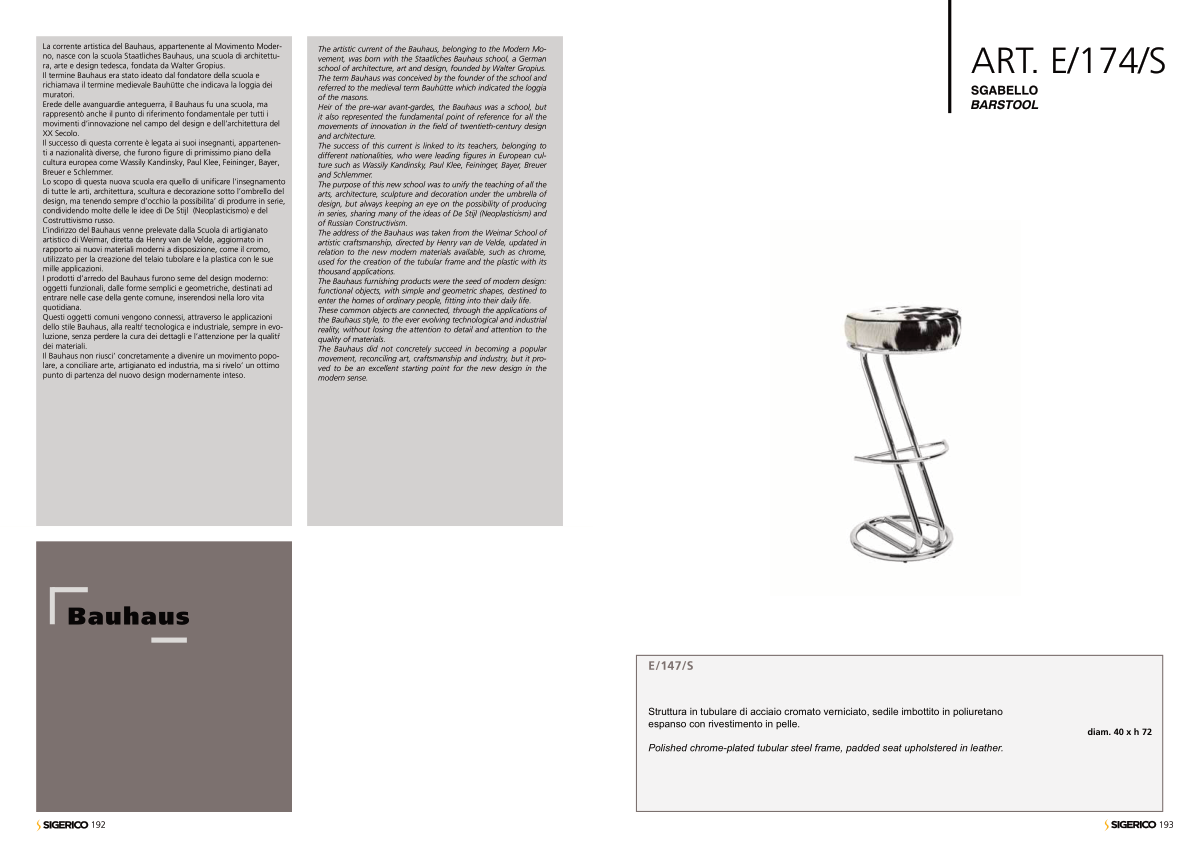La corrente artistica del Bauhaus, appartenente al Movimento Moder-
no, nasce con la scuola Staatliches Bauhaus, una scuola di architettu-
ra, arte e design tedesca, fondata da Walter Gropius.
Il termine Bauhaus era stato ideato dal fondatore della scuola e
richiamava il termine medievale Bauhütte che indicava la loggia dei
muratori.
Erede delle avanguardie anteguerra, il Bauhaus fu una scuola, ma
rappresentò anche il punto di riferimento fondamentale per tutti i
movimenti d’innovazione nel campo del design e dell’architettura del
XX Secolo.
Il successo di questa corrente è legata ai suoi insegnanti, appartenen-
ti a nazionalità diverse, che furono figure di primissimo piano della
cultura europea come Wassily Kandinsky, Paul Klee, Feininger, Bayer,
Breuer e Schlemmer.
Lo scopo di questa nuova scuola era quello di unificare l’insegnamento
di tutte le arti, architettura, scultura e decorazione sotto l’ombrello del
design, ma tenendo sempre d’occhio la possibilita’ di produrre in serie,
condividendo molte delle le idee di De Stijl (Neoplasticismo) e del
Costruttivismo russo.
L’indirizzo del Bauhaus venne prelevate dalla Scuola di artigianato
artistico di Weimar, diretta da Henry van de Velde, aggiornato in
rapporto ai nuovi materiali moderni a disposizione, come il cromo,
utilizzato per la creazione del telaio tubolare e la plastica con le sue
mille applicazioni.
I prodotti d’arredo del Bauhaus furono seme del design moderno:
oggetti funzionali, dalle forme semplici e geometriche, destinati ad
entrare nelle case della gente comune, inserendosi nella loro vita
quotidiana.
Questi oggetti comuni vengono connessi, attraverso le applicazioni
dello stile Bauhaus, alla realtà tecnologica e industriale, sempre in evo-
luzione, senza perdere la cura dei dettagli e l’attenzione per la qualità
dei materiali.
Il Bauhaus non riusci’ concretamente a divenire un movimento popo-
lare, a conciliare arte, artigianato ed industria, ma si rivelo’ un ottimo
punto di partenza del nuovo design modernamente inteso.
The artistic current of the Bauhaus, belonging to the Modern Mo-
vement, was born with the Staatliches Bauhaus school, a German
school of architecture, art and design, founded by Walter Gropius.
The term Bauhaus was conceived by the founder of the school and
referred to the medieval term Bauhütte which indicated the loggia
of the masons.
Heir of the pre-war avant-gardes, the Bauhaus was a school, but
it also represented the fundamental point of reference for all the
movements of innovation in the field of twentieth-century design
and architecture.
The success of this current is linked to its teachers, belonging to
different nationalities, who were leading figures in European cul-
ture such as Wassily Kandinsky, Paul Klee, Feininger, Bayer, Breuer
and Schlemmer.
The purpose of this new school was to unify the teaching of all the
arts, architecture, sculpture and decoration under the umbrella of
design, but always keeping an eye on the possibility of producing
in series, sharing many of the ideas of De Stijl (Neoplasticism) and
of Russian Constructivism.
The address of the Bauhaus was taken from the Weimar School of
artistic craftsmanship, directed by Henry van de Velde, updated in
relation to the new modern materials available, such as chrome,
used for the creation of the tubular frame and the plastic with its
thousand applications.
The Bauhaus furnishing products were the seed of modern design:
functional objects, with simple and geometric shapes, destined to
enter the homes of ordinary people, fitting into their daily life.
These common objects are connected, through the applications of
the Bauhaus style, to the ever evolving technological and industrial
reality, without losing the attention to detail and attention to the
quality of materials.
The Bauhaus did not concretely succeed in becoming a popular
movement, reconciling art, craftsmanship and industry, but it pro-
ved to be an excellent starting point for the new design in the
modern sense.
Bauhaus
ART. E/174/S
SGABELLO
BARSTOOL
Struttura in tubulare di acciaio cromato verniciato, sedile imbottito in poliuretano
espanso con rivestimento in pelle.
Polished chrome-plated tubular steel frame, padded seat upholstered in leather.
diam. 40 x h 72
193
192
E/147/S


